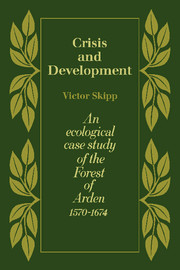Book contents
- Frontmatter
- Contents
- List of figures
- List of tables
- Acknowledgements
- PART ONE THE CONTEXT
- PART TWO THE CASE STUDY
- 4 The demographic crisis of 1613–19
- 5 Negative responses
- 6 The ecological problem
- 7 Positive responses: agrarian change
- 8 Positive responses: new employment openings
- 9 Model of demographic, economic and social developments, 1575–1649
- 10 The new ecological regime, 1625–74
- 11 The social cost
- PART THREE IMPLICATIONS
- Appendix 1 The practice of birth control
- Appendix II Estimates of population size
- Notes
- Index
6 - The ecological problem
Published online by Cambridge University Press: 05 November 2011
- Frontmatter
- Contents
- List of figures
- List of tables
- Acknowledgements
- PART ONE THE CONTEXT
- PART TWO THE CASE STUDY
- 4 The demographic crisis of 1613–19
- 5 Negative responses
- 6 The ecological problem
- 7 Positive responses: agrarian change
- 8 Positive responses: new employment openings
- 9 Model of demographic, economic and social developments, 1575–1649
- 10 The new ecological regime, 1625–74
- 11 The social cost
- PART THREE IMPLICATIONS
- Appendix 1 The practice of birth control
- Appendix II Estimates of population size
- Notes
- Index
Summary
But negative responses, while they helped to contain the ecological problem, could not overcome it. If higher populations were to be supported, the local communities would have to react positively. To what extent, therefore, is it possible to interpret the economic changes which are known to have been taking place in the five parishes during the late Elizabethan and early Stuart period as positive responses to the ecological problem?
In a pre-industrial economy the most fundamental resource is land. Down to the mid sixteenth century it may be presumed that virtually all local households would have had a landholding in excess of 4 acres and were therefore able, to a greater or lesser extent, to provide for their own subsistence.
However, a population growth of over 800, such as occurred between the 1570s and the 1600s, would have involved the establishment of something in the order of 160 to 200 new households. In other woodland districts early agrarian development had often been inhibited by forest law, or alternatively large areas had reverted to waste during the late medieval contraction. But the Arden had seen extensive colonization in the thirteenth century and little long-term agrarian contraction thereafter, any abandoned acres being promptly added to the farms of the richer more thrustful peasantry. As a result the amount of unappropriated land available in the five parishes was strictly limited. It is estimated that c. 1550 there was about 2,260 acres of common waste in all – which represented under 9% of the total area.
- Type
- Chapter
- Information
- Crisis and DevelopmentAn Ecological Case Study of the Forest of Arden 1570–1674, pp. 40 - 42Publisher: Cambridge University PressPrint publication year: 1978



